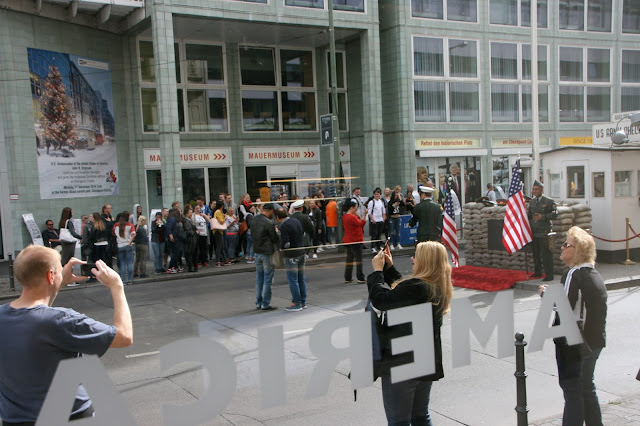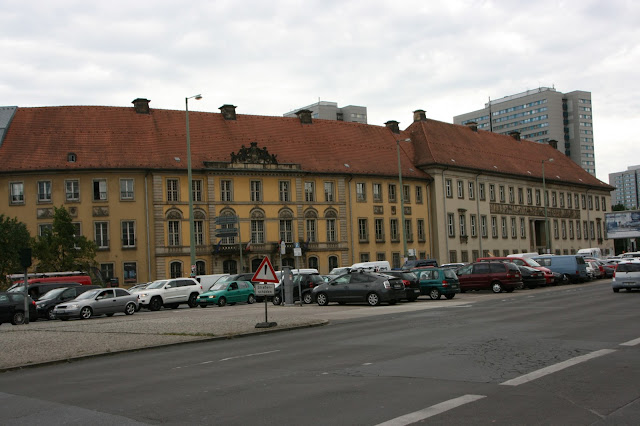Day 1
Weather - another lovely day.
Breakfast is not included at hotel so we head out. Having walked a lot yesterday we now have a better idea of how to get places. Our plan today is to get our Berlin Passes and then play it by ear.
Back across the river and another stop at this landmark.
*UPDATE* Thanks to Halcyon for the info.
The Anhalter Bahnhof is a former railway terminus approximately 600 metres (0.5 mi) southeast ofPotsdamer Platz. Once one of Berlin's most important railway stations, it was severely damaged in World War II, and finally closed for traffic in 1952, when the GDR-owned Deutsche Reichsbahn rerouted all railway traffic between Berlin and places in the GDR avoiding the West Berlin area.
Click here to read about our visit to Theresienstadt.
We choose Einstein's Cafe across from Checkpoint Charlie's for breakfast for some more entertainment.
The BEST strudel ever.
Photos as we make our way. Lots of construction blocking our front view of this magnificent building.

The Zeughaus (old Arsenal) is the oldest structure at Unter den Linden. It was built by the Brandenburg Elector Frederick III between 1695 and 1730 in the baroque style, to be used as an artillery arsenal for the display of cannons from Brandenburg and Prussia.
Today, the Zeughaus is the site of the Deutsches Historisches Museum (German Historical Museum).
Finally find the Berlin Pass office beside the Humboldt Box and get our pre-paid pass package. We first spent time in the Humboldt Box looking for the office as it was the address I was given.
The Humboldt Box is a futuristic museum structure on the Schloßplatz. It was built as a temporary exhibition space and viewing platform for the Berlin Palace - Humboldt Forum construction project and to inform the public about its future use.
This is a model of the area when the Palace (large square building aross from Dom and Altes Museum) is constructed.
\We decide to cross over towards the Berliner Dom.
Once across we realize we are on Museum Island and since we have Berlin Passes we have free entry to most museums we decide to check out the Altes (Old) Museum on the left in photo above.
Museums are such civilized places for bathroom breaks!
Photos allowed but no flash, however all bags must be left in the garderobe or cloakroom.
The inscription on the portico reads: ‘Friedrich Wilhelm III has dedicated this museum to the study of all antiquities and the free arts, 1828’.
Museum Island (or, in German, Museumsinsel) is the name of the northern half of an island in the Spree River, in the center of the city. Located on the island are the Old Museum, the New Museum, the Old National Gallery, the Bode Museum, and the Pergamon Museum. South of the five museums are the Berlin Cathedral.
We pass the Neues Museum on our way to the Dom.
Berlin Cathedral (German: Berliner Dom) is the short name for the Evangelical (i.e. Protestant) Supreme Parish and Collegiate Church (German: Oberpfarr- und Domkirche). It is located on Museum Island in the Mitte borough. The current building was finished in 1905.
Entry was included with our Berlin passes but I would have paid anyway!!
Our first view of the Spree River with its sidewalk cafes.
The East German pedestrian traffic light symbols, or‚ ampel men’ are Berlin born and bred. They came into being on October 13th 1961 when, in response to the growing threat of road traffic accidents,
There are even souvenir shops devoted to selling these souvenirs. Just wait until we get to Frankfurt!
We have the idea (and phone GPS) to walk to the East Wall Gallery. We know we should be able to find it by sticking to the river but the GPS gets us totally turned around and we change our minds.
The Dom from another bridge.
"All who wander are not lost". Well we are but find interesting sights along the way.
We find ourselves back near Checkpoint Charlie so decide to do the museum.
More posing.
Click here to watch a great video.
Originally opened in 1962 by Dr. Hildebrandt in two-and-a-half rooms to protest the newly erected Berlin Wall in 1961, its popularity outgrew its original location and it was moved to its present location at the Checkpoint Charlie border crossing in 1963. Because of its location, the museum café became a popular meeting point to plan escapes.
Some of the escape objects on display include:
Cars – VW Beetle and even cars as small as a Mini and a BMW Isetta
Suitcases
Welding equipment
Ladders
Self-made aircraft and hot-air balloons
Surfboards
A self-made U-boat – the inventor sold the concept to a Western company and developed further mini U-boats for sport, commercial and military use.
During the Berlin Wall period (1961-89), at least 5,000 people successfully escaped from East Germany while at least 1,600 lost their lives while trying to flee.
The mural is on the outside wall of the office of Berlin's alternative left-wing Die Tageszeitung (Taz) newspaper.
The restaurant downstairs was mentioned by Halcyon's husband last night.
No photography but I managed a few. Funny no one said anything to me when I took this photo which was right over the admissions desk.
So many heroic stories of escape attempts and successes. Click here for a true life story of a young girl behind the Wall and escaping to the West in a Beetle like this one.
Some of the escape objects on display include:
Cars – VW Beetle and even cars as small as a Mini and a BMW Isetta
Suitcases
Welding equipment
Ladders
Self-made aircraft and hot-air balloons
Surfboards
A self-made U-boat – the inventor sold the concept to a Western company and developed further mini U-boats for sport, commercial and military use.
When we stepped out I noticed the street name and realized we were close to the "penis" mural that Halcyon had blogged about and mentioned last night when we met.
You can read about the meaning of the mural in Halcyon's post. Or click here for a newspaper article.
The mural is on the outside wall of the office of Berlin's alternative left-wing Die Tageszeitung (Taz) newspaper.
The restaurant downstairs was mentioned by Halcyon's husband last night.
So we set out to find it and it was immediately across the street.
Across the street is another newspaper office.
Feeling a little peckish we stop into a Spanish tapas bar, Barcelona, for beer/wine. I am so impressed that I can read the menu board listing pepper pate with toast until I realize it is in Spanish!!! Odd we're in a Spanish tapas bar and the server cannot figure out what I am ordering when I point to it on the board. Eventually we get our pate and happily much away.
We drag our weary bodies back to the hotel and decide to eat in the bar there.
John has pizza and I choose to try the Berlin famous dish currywurst. I did not like and would never order it again!
Currywurst - fast food dish of German origin consisting of steamed, then fried pork sausage (German: Bratwurst) whole or less often cut into slices and seasoned with curry ketchup, a sauce based on spiced ketchup or tomato paste, itself topped with curry powder, or a ready-made ketchup seasoned with curry and other spices.
Currywurst - fast food dish of German origin consisting of steamed, then fried pork sausage (German: Bratwurst) whole or less often cut into slices and seasoned with curry ketchup, a sauce based on spiced ketchup or tomato paste, itself topped with curry powder, or a ready-made ketchup seasoned with curry and other spices.
I like ketchup and curry but this just did not work for me.
Distance covered 11.8 kilometers or 7 miles!
Monday Walks Our World Tuesday







































































Well done babe. Good coverage.
ReplyDeleteSuch magnificent architecture there, Jackie. You've photographed it beautifully.
ReplyDeleteThanks, William, it really is a beautiful city.
DeleteI love seeing the place where I live through someone else's eyes! :)
ReplyDeleteYour first "landmark" is the remains of Anhalter Bahnhof. They decided not to restore it after the war, but just leave the remnants. That must have been near your hotel.
That red brick building is Berlin's City Hall (known as the Rotes Rathaus). It is in the former East, but became the main city hall for Berlin when the two Germanys got back together.
I am looking forward to more!
Thanks for the info. I tried everything to find what the first landmark was called. Goggles would only recognize it as a "German landmark". Yes, it was really close to our hotel so we passed it every day.
DeleteGerman Landmark... that is funny! From now on, when I don't know something, I'll just call it German Landmark.
DeleteHa!! I ordered the currywurst too last time I was in Germany. UGH.
ReplyDeleteYou're doing a pretty thorough job, Jackie! Love the maps and those museums look like you could lose many an hour. Thanks a lot for the link up. :)
ReplyDeleteThe wall left quite an impression on me when I was younger.
ReplyDeleteFantastic architecture and I loved all the different sculptures.
ReplyDeletewonderful photos!
ReplyDeleteWonderful photos! We visited Berlin a few years ago, but it was raining when we walked around the Dom.
ReplyDelete